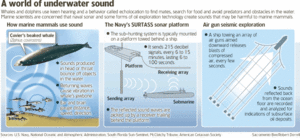We pierce the depths with sub-seeking sonar. We rattle them with oil-exploration blasts. And we churn out a constant din from shipping.
The sounds sometimes kill, leaving beaked whales dead on shore after military exercises.
Far more often, our noise muffles the perceptual world for marine creatures that rely on sound for hunting, courting and just finding their way around.
"We should all be concerned with increased ocean noise," said Paul Nachtigall, director of the University of Hawaii's marine mammal research program.
While some have wondered whether noise drove these two whales inland, experts consider it highly unlikely.
Yet with sonar linked to beached whales from the Canary Islands to the Bahamas, questions linger about how much we're disrupting the seas.
Among those concerned is the California Coastal Commission, which sued the U.S. Navy in March, trying to force it to better protect whales during maneuvers off Southern California.

|
| ©sacbee |
Those Navy exercises are also the target of a lawsuit by environmental groups, and other naval training is facing litigation in Hawaii and beyond.
Humpbacks are not among the species believed most vulnerable to military sonar, but they and other sound-dependent marine life cannot escape humanity's growing clatter.
"We've changed the environment," said John Hildebrand, a professor specializing in marine acoustics at the Scripps Institution of Oceanography at UC San Diego. "Has it ... put them into areas more marginal for them?"
Noise levels in the Pacific have been going up around 3 decibels a decade for the past 40 years, largely because of shipping, Hildebrand said.
It's safe to assume the background noise was at least 20 decibels lower before modern shipping, he said.
So tens of thousands of species whose hearing we understand poorly have had to adjust -- if they can. Researchers don't even know which ones can compensate for the added noise, the way people turn up the radio when they drive on a freeway.
It is known that porpoises, dolphins and the rest of the roughly 80 species lumped together as cetaceans rely on sound because it travels better underwater than light.
Many smaller whales make their own sonar, uttering dozens or hundreds of clicks per second and analyzing the returning sound to map what's ahead, a process called echolocation.
Humpbacks don't echolocate but might use their own sounds to help avoid large objects. And humpbacks have a special relationship with song, performing the longest, most complex music of any mammal except humans, Hildebrand said.
"The singing of male humpbacks is clearly an important part of their culture," he said, with males competing during mating season to show "who can sing the loudest, longest, coolest song."
When David Mellinger, an Oregon State University specialist in whale acoustics, put microphones deep in the mid-Atlantic, he was startled to find almost constant noise from distant oil and gas exploration -- seismic air guns shot off every 20 seconds to analyze the seabed in search of oil and gas deposits.
Air guns, Mellinger and others say, are probably the second largest source of human ocean noise, second to shipping.
Scripps' Hildebrand is among those who believe international sound standards are needed to limit how noisy ships can be, just as there are limits to waste that can be thrown overboard.
Earlier this month, industry representatives met with federal officials and scientists to talk about making vessels quieter.
Work is under way, too, on the less widespread but more intense noise from military sonar.
Researchers are working with military-trained dolphins off San Diego to analyze physiological effects that might contribute to sonar-related deaths.
Other scientists are getting ready to test various noises for beaked whales off the Bahamas this summer, hoping to identify the worst.
Beaked whales are elusive, deep divers, bigger than dolphins but smaller than humpbacks, that amble dreamily 500 meters to a kilometer deep, using echolocation to spot squid or other prey they suck into their mouths as if they were slurping noodles.
Most of the sonar-related deaths have involved several beaked whale species, but no one is sure how many species are at risk, or why.
"There's something else besides just turning a sonar on that probably factors into this," said Bob Gisiner, marine mammal science program manager for the Office of Naval Research.
Possibilities include the combined effects of many moving sonar sources, underwater slopes or canyons that may pen fleeing animals, and special temperature conditions that could amplify sound.
The actual cause of death is also a mystery, with speculation ranging from a whale version of the bends to noise-fueled oscillations in the lungs to simple panic-driven beachings.
Complicating things further, the U.S. Navy is often both suspect and detective amid these unknowns, funding marine noise research even as it defends its right to use sonar in military training without standard environmental reviews.
Darlene Ketten, a senior scientist at Woods Hole Oceanographic Institution and an expert in marine mammal ears, is among those saying it's important to keep using underwater sounds -- but cautiously.
"You have to avoid putting any sound the animal is capable of hearing into critical habitats unless you know the sound is not going to be disruptive," she said.



Reader Comments
to our Newsletter